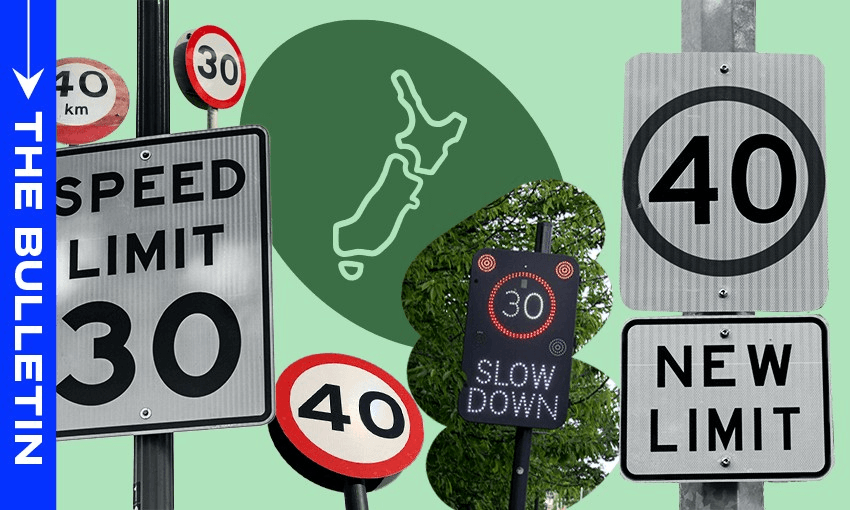38 sections of state highway up and down the country are about to have their speed limits increased. The Bulletin’s Stewart Sowman-Lund explains why.
To receive The Bulletin in full each weekday, sign up here.
Speed limits going back up
On Tuesday morning, prime minister Christopher Luxon joined Newstalk ZB’s Mike Hosking for his first weekly interview of 2025. It was a rather combative exchange, somewhat unusual given the cosy rapport the pair seem to have. “You’re too much yak* and not enough do,” Hosking said to Luxon. Later: “My frustration with you is that I think you’re well-intentioned, but you’re running out of time.” And then: “You’re going to run out of runtime if you don’t start kicking some arse and getting this country moving.” Hosking took issue with a number of areas he perceived the government as being sluggish, but he saved his final blow for something close to his heart: speed limit changes. Luxon said he’d “get onto it”, and just shy of 24 hours later, an outcome (though not exactly the one Hosking had been asking for). As we touched on yesterday, the government has confirmed it will reverse speed limit reductions implemented by the former government across 38 sections of state highway up and down the country in a bid to bolster productivity. A further 49 sections of state highway will be put out for public consultation.
*Not the animal.
‘Triumph for common sense’ or a ‘political decision’?
In announcing the decision, newly-minted transport minister Chris Bishop said the government wanted to make it easier for people to get from A to B “which will help drive economic growth and improved productivity.” Act’s leader David Seymour said it was a “triumph for common sense” (the pledge to increase speed limits was included in the National-Act coalition agreement). In Wairarapa, where the announcement was made, the changes could amount to about three minutes of travel time saved. However on shorter stretches of road, calculated Stuff’s Karanama Ruru, it could be as little as 15 seconds. Bishop argued it was worth it. “While these changes may appear small in some cases, collectively when you add up the volume of traffic across all these corridors every day, it makes a big difference,” he said.
The opposition has claimed that it’s a purely political decision and one that will cost lives. As reported by ThreeNews last night, the announcement was made on the corner of a road where someone had previously lost their life. Labour’s Chris Hipkins, speaking to reporters, went so far as to suggest National would be responsible for any increase in road deaths. “If more people die on those roads because of the political decision to increase the speed limits then that’s going to be on National,” he said. The transport minister said drunk and drug drivers were the major cause of road deaths and the government has committed to tackling this problem, as we looked at for The Bulletin last year.
‘Higher speeds often result in increased costs’
The government’s position is that by allowing people to get where they need to be faster – albeit only slightly – it will mean they can achieve more. The Spinoff’s Toby Manhire looked at the debate, and the strong opposition to the government’s moves, in an explainer published last August. Though campaigned on well before Christopher Luxon started talking about economic growth in practically every sentence, the pledge has been rolled out as part of the government’s plan to reinvigorate the economy. In a piece for The Conversation last year, urban planning expert Timothy Welch argued that thinking was flawed. “Higher speeds often result in increased costs rather than improved efficiency,” he wrote. That can be caused by “disproportionate increases in fuel consumption”, but also the heavy financial burden from increased road accidents, explained Welch.
Canterbury university’s Simon Kingham, a former chief science advisor at the Ministry of Transport, made similar arguments in a piece for Newsroom, noting that the government was only pitting time savings against accidents and “ignoring pollution emissions… ignoring mode shift which is a really big one because if you make a speed limit slower, you encourage walking and cycling”.
As RNZ reported, the government will face a legal challenge from a safety advocacy group over its decision.
Local decision making ‘undermined’
Meanwhile, it’s been claimed the government’s decision to take a blanket approach to speed limit adjustments overrides the views of local communities. The Spinoff’s Joel MacManus made a similar point in a piece for The Spinoff last year, arguing that while some local councils had been responsible for reducing speed limits in their towns, the government – that has advocated for local solutions to local issues – had decided to take a wholesale approach. Tina Law, reporting for The Press, said that the Christchurch City Council had been working to reduce speed limits outside schools to 30km/h at all times of the day, but the government will require this only to be in force during pick up and drop off times. Harrison McEvoy from the group Greater Ōtautahi said this ignored community preference and undermined local decision making.


